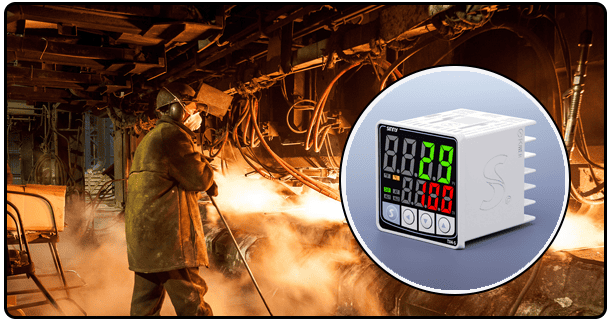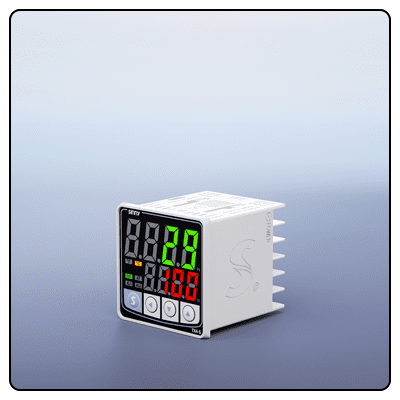Implementing PID Temperature Control in Existing Systems
Step into a world of precision with our guide on Implementing PID Temperature Control in Existing Systems, offering expert insights for improving system efficiency, decreasing wasteful spending and creating cost savings by installing, tuning and maintaining PID temperature controllers in existing systems.
1. Introduction
PID Temperature Control
Proportional, Integral and Derivative (PID) temperature regulation is a sophisticated strategy used in industrial settings to maintain precise temperature regulation. This control strategy continuously calculates an error value as the difference between desired setpoint and measured process variable temperatures before applying corrective adjustments based on proportional, integral, and derivative terms to restore temperature to ideal levels.
Industrial Applications
PID controllers play an essential role in improving efficiency and accuracy within industrial systems by maintaining steady temperatures at optimal production stages to optimize production processes, reduce energy usage, and enhance product quality.
Integrating PID Control
Integrating PID control into existing systems provides numerous advantages:
PID controllers improve efficiency by maintaining consistent temperatures without manual adjustments and energy waste, leading to greater consistency for quality products and reduced defects.
They also contribute towards efficiency by keeping temperatures within target parameters, eliminating manual adjustments while simultaneously optimizing energy use. They improve accuracy through precise temperature regulation which leads to higher quality products with reduced defects and waste.
Cost Savings: By optimizing energy use and decreasing waste production, PID controllers contribute significantly to cost reduction in industrial settings.
2. Analyzing System Compatibility
Evaluating Current Systems for PID Implementation Before installing PID controllers into existing systems, it's critical to conduct an assessment on their compatibility. This involves reviewing current control infrastructure as well as processes requiring temperature regulation as well as any specific requirements related to PID control implementation.
Implementation Challenges and Solutions
Implementing PID controllers may present several difficulties, such as:
System Compatibility: Ensuring PID controllers are compatible with existing hardware and software systems.
Calibration: Aligning their calibration with process requirements as specifically as possible. Training: Equipping personnel to use and maintain these new controllers efficiently.
Approaches for meeting these challenges include conducting an in-depth system evaluation, selecting suitable PID controllers and providing intensive operator training.
3. Selecting an Appropriate PID Controller
Finding an ideal PID controller involves considering several criteria. These factors include:
Process Requirements: Deliberating upon the specific temperature control needs of the process.
Controller Features: Evaluating features provided by various controllers such as autotuning capabilities, communication features and user interface features.
System Compatibility: Ensuring the controller can integrate seamlessly with existing systems is of utmost importance.
Types and Suitability of PID Controllers Different PID controllers exist, each suitable for specific applications:
Standard PID Controllers: Ideal for simple temperature regulation applications. Programmable PID Controllers: Suited to more complex processes requiring customized control strategies. Multi-Loop PID Controllers: These multi-loop devices can simultaneously regulate multiple temperature zones.
4. Installation and Configuration
Step-By-Step Installation Guide on PID Controllers
Implementing PID controllers requires several steps; here is our step-by-step installation guide:
System Prep: Prior to installation, ensure your system is prepared by verifying power supplies and connectivity, mounting its controller securely according to manufacturer's instructions, and prepping any peripheral devices necessary for its proper function.
Connecting Sensors and Actuators: Properly connect temperature sensors and actuators to the PID controller, before powering up. After turning up, verify the PID is receiving appropriate signals by testing for proper functioning.
Best Practices for Configuring PID Settings
Tuning PID settings is vital in order to reach optimal performance: it ensures optimal outputs from any machine or process.
Setpoint Configuration: Define a desired temperature setpoint for your process.
PID Parameter Tuning: Align proportional, integral and derivative parameters with process dynamics. Initial Testing: Perform initial tests to make sure that the controller responds as intended when temperature fluctuations arise.
5. Tuning and Optimization
Tuning PID controllers effectively requires:
Manual Tuning: Manual adjustments of PID parameters according to system response are used as the foundation for manual tuning. Primari Auto-Tuning: Autotune features of controllers can automatically identify optimal parameters. Ziegler-Nichols Method is an approach used in systematic tuning based on ultimate gain and oscillation period as measures of tuning success.
Strategies for Ongoing Optimization
Ongoing optimization ensures the PID system continues to perform efficiently:
Regular Monitoring and Tune Ups (RM/Tune-ups): Monitor system performance closely and adjust as necessary, while Scheduled Maintenance should take place to ensure all components are working as intended.
Feedback from Operators: Collect feedback from operators in order to identify any potential issues or areas for enhancement.
6. Case Studies and Real World Examples
Case Studies of PID Implementation
Multiple case studies highlight the advantages of PID implementation:
HVAC Systems: One commercial building successfully implemented PID controllers into its HVAC system to see an impressive 15% drop in energy costs.
Plastic Molding: Plastic manufacturing company implemented PID controllers onto molding machines using them PID controllers as regulators resulting in 10-20% less material waste being created by molding processes.
Analysis of PID Temperature Control's Impact and Savings
Analysis of the effect of PID temperature control reveals significant improvements, both to system performance and savings:
PID controllers offer more stable temperature regulation, decreasing process variability. Their increased efficiency and reduced waste lead to significant cost reduction.
Increased Productivity: More consistent processes result in both higher productivity and superior product quality, leading to greater overall efficiency and product satisfaction.
7. Training and Knowledge Transfer
Staff education is integral for successful operation and maintenance of PID controllers: it should include proper use and care procedures as well as knowledge transfer between personnel members.
Understanding Controller Operation and Adjustments: Operators need a firm grasp on how to operate and adjust controllers properly, while maintenance skills training ensures optimal condition is maintained over time.
Troubleshooting: Learning troubleshooting techniques helps quickly address any problems that may arise.
Resources Available for Continued Learning
There are various resources available to aid continued learning and expertise development:
Technical Manuals: Manufacturer-provided manuals provide detailed information about controller operation and maintenance, while online courses/webinars offer in-depth training in PID control principles and applications.
Attend Industry Conferences/Workshops: Attending industry conferences can keep you abreast of all of the latest advances in PID technology.
8. Conclusion
Implementing PID temperature control involves several key steps:
Assess System Compatibility: Evaluate existing systems to see whether they can support PID controllers. Select Appropriate Controllers: When choosing appropriate controllers for process needs, follow best practices when installing and configuring them.
Tuning and Optimizing: Optimize controller performance continuously through tuning and optimization processes.
Training Personnel: Train operators on how to operate and maintain PID controllers properly.
Long-Term Benefits of Upgrading to PID Systems
Upgrading PID systems offers long-term advantages, including:
Reliability: PID controllers offer reliable temperature regulation that minimizes process variability. Cost-Efficiency: By improving efficiency and cutting waste, PID controllers allow businesses to realize substantial long-term cost savings.
Sustainability: PID controllers contribute to more environmentally sustainable operations by minimizing energy use and material waste production.
- PID Temperature Controllers: Enhancing Safety and Reliability
- How PID Temperature Controllers Reduce Waste and Save Costs























